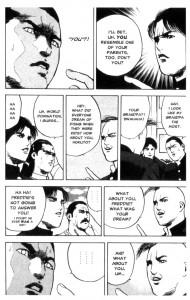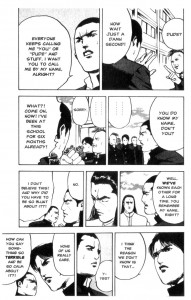
before Watchmen: Conway & Kane’s Amazing Spider-Man 122
June 27th, 2012 Posted by david brothers
This is the last page of Amazing Spider-Man 122, the issue after Gwen Stacy dies. It’s right in the middle of one of my most favorite runs on any comic ever. Gerry Conway on words, Gil Kane on pencils, John Romita & Tony Mortellaro on inks, and Dave Hunt on colors.
The first 140 or so (I’ve never done a real count, but around there) issues of Amazing Spider-Man are my Lee/Kirby Fantastic Four, and this is one of my favorite single pages out of that entire run.
Steve Ditko gave Spider-Man a creepy outsider feel. When Ditko left and Jazzy Johnny Romita became the principal artist, the tone changed to something more influenced by romance comics and soap opera. Peter became a lot more handsome, the clothes were swinging, and the girls turned from pretty to supa dupa fly. The comic got a lot sexier, is what I’m saying, and Mary Jane Watson had a lot to do with that.
The usual line is that Mary Jane was the party girl, while Gwen was the wholesome girl next door. I don’t know if that’s actually true, but it’s a fair enough starting point if you want to branch out into a deeper understanding of the characters. MJ was definitely a popular girl, the type you’d describe as “hot” instead of “pretty.” Lesser writers took that to mean that she was an airhead or vapid, but that was never true. But she definitely represented a somewhat edgier kind of excitement than Gwen did.
Part of the mythos of Spider-Man is that Peter Parker is an extraordinarily selfish person. Or maybe just regular selfish — it’s hard to tell when everything in cape comics is so heightened. But he takes everything personally, and he tries to walk around with the weight of the world on his shoulders. He snaps and buckles under pressure before regaining his strength, but that snapping is the important part. Peter Parker needs support. He needs someone to tell him things are okay or to have his back in a pinch. Spider-Man is a role Peter Parker plays, not Peter Parker himself.
What I love about this page is how it shows the quiet strength and determination that Mary Jane always had underneath her party girl exterior. She’s been waiting at Peter and Harry’s pad for hours, praying for someone to talk to. The problem is that it’s dumb ol’ Petey, a guy who never met a problem that wasn’t his fault. He lashes out at her in his grief, ignoring her own grief, and instead of doing what anyone else would do, MJ turns to leave, pauses, and chooses to stay.
There’s something about the choice she makes between panels here that really, really sticks with me. MJ isn’t just a supporting character, a prop for someone else’s grief. Not when she’s written well, anyway. This choice feels significant, for both her and Peter. It’s one of my absolutely favorite scenes in Spider-Man comics, and I don’t know that I could tell you exactly why. There’s just tremendous emotional resonance there, and a certain finality and acceptance, that I really appreciate. She chooses to share her grief, whether Peter wants her to or not.
It’s like — does she recognize something in Peter? Is it something she also recognizes in herself? Why does she choose to forgive him for his anger? I think she recognizes how people run away from love and support, in part because she herself is also guilty of that.
There’s something deep lurking around here, right below the surface, and I love it. It’s like Spider-Man is shifting (or continuing its shift, really) from childhood to adulthood, transforming directly on the page, and making permanent decisions that other comics wouldn’t, and modern comics don’t. Part of the fun of the first 140 issues of Amazing Spider-Man grow from a 15 year old kid to a college-age adult, and this scene is a milestone moment.


